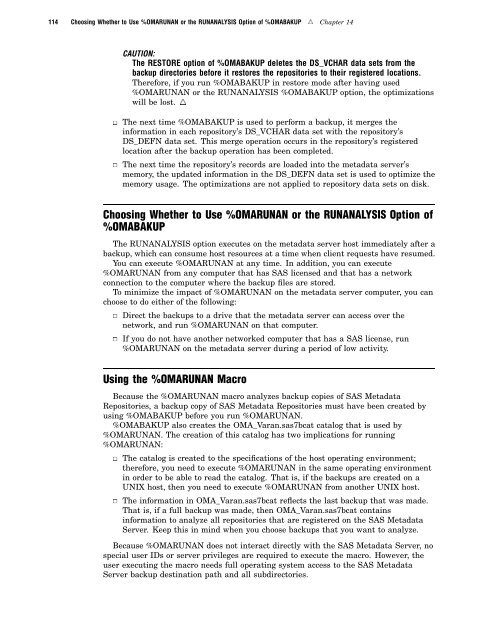SAS 9.1.3 Intelligence Platform: System Administration Guide
SAS 9.1.3 Intelligence Platform: System Administration Guide
SAS 9.1.3 Intelligence Platform: System Administration Guide
You also want an ePaper? Increase the reach of your titles
YUMPU automatically turns print PDFs into web optimized ePapers that Google loves.
114 Choosing Whether to Use %OMARUNAN or the RUNANALYSIS Option of %OMABAKUP R Chapter 14<br />
CAUTION:<br />
The RESTORE option of %OMABAKUP deletes the DS_VCHAR data sets from the<br />
backup directories before it restores the repositories to their registered locations.<br />
Therefore, if you run %OMABAKUP in restore mode after having used<br />
%OMARUNAN or the RUNANALYSIS %OMABAKUP option, the optimizations<br />
will be lost. R<br />
3 The next time %OMABAKUP is used to perform a backup, it merges the<br />
information in each repository’s DS_VCHAR data set with the repository’s<br />
DS_DEFN data set. This merge operation occurs in the repository’s registered<br />
location after the backup operation has been completed.<br />
3 The next time the repository’s records are loaded into the metadata server’s<br />
memory, the updated information in the DS_DEFN data set is used to optimize the<br />
memory usage. The optimizations are not applied to repository data sets on disk.<br />
Choosing Whether to Use %OMARUNAN or the RUNANALYSIS Option of<br />
%OMABAKUP<br />
The RUNANALYSIS option executes on the metadata server host immediately after a<br />
backup, which can consume host resources at a time when client requests have resumed.<br />
You can execute %OMARUNAN at any time. In addition, you can execute<br />
%OMARUNAN from any computer that has <strong>SAS</strong> licensed and that has a network<br />
connection to the computer where the backup files are stored.<br />
To minimize the impact of %OMARUNAN on the metadata server computer, you can<br />
choose to do either of the following:<br />
3 Direct the backups to a drive that the metadata server can access over the<br />
network, and run %OMARUNAN on that computer.<br />
3 If you do not have another networked computer that has a <strong>SAS</strong> license, run<br />
%OMARUNAN on the metadata server during a period of low activity.<br />
Using the %OMARUNAN Macro<br />
Because the %OMARUNAN macro analyzes backup copies of <strong>SAS</strong> Metadata<br />
Repositories, a backup copy of <strong>SAS</strong> Metadata Repositories must have been created by<br />
using %OMABAKUP before you run %OMARUNAN.<br />
%OMABAKUP also creates the OMA_Varan.sas7bcat catalog that is used by<br />
%OMARUNAN. The creation of this catalog has two implications for running<br />
%OMARUNAN:<br />
3 The catalog is created to the specifications of the host operating environment;<br />
therefore, you need to execute %OMARUNAN in the same operating environment<br />
in order to be able to read the catalog. That is, if the backups are created on a<br />
UNIX host, then you need to execute %OMARUNAN from another UNIX host.<br />
3 The information in OMA_Varan.sas7bcat reflects the last backup that was made.<br />
That is, if a full backup was made, then OMA_Varan.sas7bcat contains<br />
information to analyze all repositories that are registered on the <strong>SAS</strong> Metadata<br />
Server. Keep this in mind when you choose backups that you want to analyze.<br />
Because %OMARUNAN does not interact directly with the <strong>SAS</strong> Metadata Server, no<br />
special user IDs or server privileges are required to execute the macro. However, the<br />
user executing the macro needs full operating system access to the <strong>SAS</strong> Metadata<br />
Server backup destination path and all subdirectories.
















